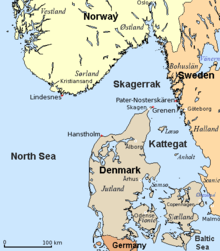|
Operation Rubble Operation Rubble in January 1941, was a British blockade running operation during the Second World War, in which five Norwegian merchant ships escaped from neutral Sweden to Britain through a Nazi German blockade of the Skagerrak, carrying valuable cargoes of specialised steel products. Background The German invasion of Denmark and Norway, Operation Weserübung, in April 1940, effectively closed the Baltic Sea to shipping and denied the British access to Swedish iron and steel products. Even before the war, some 20% of roller and ball bearings used by British industry were imported from Sweden, together with high-quality tubing and other specialised products which were not available elsewhere. The most desperately needed resource was roller bearings for a strip mill which was nearing completion at Ebbw Vale. An additional factor was that the United Kingdom had negotiated the Anglo-Swedish War Trade Agreement in October 1939, which limited Swedish exports to their 1938 levels, with a similar agreement having been reached with the Germans; the fear was that if exports to Britain were allowed to lapse, the Germans would be able to pressure the Swedes into renouncing both the agreements and monopolise production for their own use. A considerable quantity of British-ordered materials were therefore stockpiled in Sweden, together with large orders made by France which had been signed over to Britain before their surrender. These supplies were desperately needed in Britain and the Swedish government was anxious to be rid of them to avoid antagonising the Germans.[1] The man tasked with shipping the steel to Britain was George Binney, the representative of the British Iron and Steel Federation in Sweden. His first efforts were a small shipment made by sea from the port of Petsamo (now Pechenga in Russia) on Finland's Arctic coast, followed by a second larger one which went by rail through Finland and across the USSR to the Caspian Sea and then through Iran to the Persian Gulf. However, following the end of the Norwegian Campaign in June 1940, the Finns were pressured by the Germans into denying any further access. This left passage by sea through the Skagerrak, the narrows between occupied Denmark and Norway, as the only option.[2] Preparation Laid-up in Swedish ports were more than twenty Norwegian merchant ships. Shortly before leaving the country, King Haakon VII of Norway had approved legislation which requisitioned all Norwegian shipping under the control of a directorate called Nortraship based in London. Binney devised a plan in which these ships would be used to store British stockpiles and the most capable could be used for a breakout. The Germans were well aware of this possibility and not only was the Skagerrak regularly patrolled by naval vessels and aircraft, but an extensive minefield had been laid across the straight. Blinney suspected that the minefield was not as comprehensive as the Germans had claimed and with the encouragement of London, chartered a small Finnish tramp steamer, Lahti, to attempt the run. Departing Gothenburg on 5 July 1940 carrying 300 tons of steel products, Lahti successfully traversed the Skagerrak, however the short night allowed her to be spotted by German aircraft and her master obeyed their instruction to head for Kristiansand and internment, but the point had been proved.[3] Binney spent the following months selecting the fastest of the Norwegian ships, persuading their masters and crews to undertake the voyage and obtaining the necessary clearances from the Swedish authorities. Those Norwegians unwilling to take the risk were replaced by volunteers from the British Merchant and Royal Navy crews who had escaped from Norway and were held in an internment camp at Hälsingmo near Söderhamn in central Sweden.[4] Escape The ships involved were Norwegian steamships Elizabeth Bakke (5,450grt), John Bakke (4,718grt), Tai Shan (6,962grt), Taurus (4,767grt) and Ranja (6,355grt).[5] The ships left Gothenburg singly on 30 December and anchored in Brofjorden, which was further north up the coast and away from German surveillance. Binney himself sailed in Tai Shan.[6] There they awaited a weather forecast of poor visibility, which was finally received for the night of 23 January 1941, when they began their run of the German blockade. They narrowly avoided being intercepted by the two German battleships Scharnhorst and Gneisenau who were just starting Operation Berlin in the Kattegat. The ships navigated the North Sea with aircraft from RAF Coastal Command and various warships being dispatched from Scapa Flow to act as escorts. These escorts included HMS Naiad, HMS Aurora, HMS Edinburgh and HMS Birmingham and the destroyers HMS Escapade, HMS Echo, HMS Electra. John Bakke and Ranja were both under attack from the Luftwaffe when the cruisers found them. The ships reached Kirkwall in Orkney on 25 January 1941. The Swedish mate of Ranja later died from bullet wounds.[7][8] The ships successfully delivered approximately 18,600 metric tonnes of materiel including ball bearings, machine tools, spare parts, iron, ingots, and steels of various qualities.[9] AftermathAs a result of "Rubble", Binney received a knighthood in the 1941 Birthday Honours List[10] "for special services in the supply of war material".[11] A second operation launched on 31 March 1942, Operation Performance, involving six more Norwegian ships was less successful; lacking surprise and optimal weather conditions, two ships were forced to return to Sweden, two were sunk and only two reached Britain, carrying 27% of the original cargo.[12] A change of tactics for Operation Bridford saw the use of converted motor gunboats, which made six return trips between October 1943 and March 1944 carrying some 25,000 tonnes of cargo.[13] The same tactics were employed for Operation Moonshine starting in September 1944 which was largely frustrated by poor weather and mechanical defects; a single mission in January 1945 reached Sweden, although the two of the three boats involved collided, resulting in the loss of one of them.[14][15] References
Sources
Other sources
|